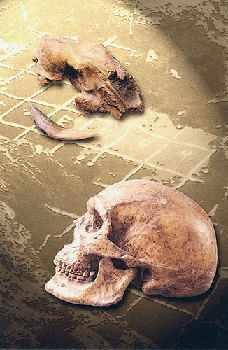Location: Zhoukoudian Site is an archaeological site of the Early Paleolithic Age. The locations of the Beijing Man and the Upper Cave Man were both discovered in the Fangshan District of Beijing in 1921.
Period: The Peking Man is 700,000-200,000 BP (before present); the Upper Cave Man is 18,000 BP
Significance: The findings have disclosed the origin of human beings in the Orient, and offered solid proofs for the theory of human evolution.
 Introduction
Introduction
1. Zhoukoudian Site
An important Paleolithic site, this site was first excavated in 1927, in a cave on Dragon Bone Hill at Zhoukoudian, southwest ofBeijing. In 1929, skull fossils of Peking Man were discovered here, providing concrete evidence for the existence of primitive man in theBeijingarea and marking a milestone in the history of paleo-anthropology. So far, a total of 6 skulls, 15 pieces of lower jawbones, 157 teeth and numerous other bone segments from the bodies of about 40 humans have been excavated, providing concrete data for the study of the evolution of pre-historic biology and the development of pre-historic culture.
2. Peking Man
 |
| Fossil skull of sabre-toothed tiger: (up); Fossil canine tooth of sabre-toothed tiger: (mid); Fossil cranium of the Upper Cave Man: (bottom, cranial capacity is around 1300 ml-1500 ml) |
Peking Man was among the first human beings to learn how to use fire, and could hunt large animals. Their average life expectancy was short; it is estimated that 68.2% of them died by the age of 14, and only 4.5% lived up to 50 years. The study of geological strata indicates that Peking Man lived about 700, 000 to 200,000 years ago. The average brain volume of these people was 1,088 ml (the average for modern people is 1,400 ml). And it is estimated that their average height reached 156 cm for males and 150 cm for females.
As primitive men evolved from ape men to intelligent men, Peking Man learned how to make tools in the early Paleolithic period, marking them as humans, different from apes. Peking Man still serves as the benchmark for judging whether an ancient creature was an ape or homo sapiens.
3. Upper Cave Man fossils
Fossils of the Upper Cave Man living 18,000 years ago were excavated near the top of Dragon Bone Hill in the same region of the Peking Man. Their outlook was almost alike to modern men. The Upper Cave Man still used ground stone tools, but they knew how to polish and drill holes on stones, and they also knew how to make bone needles and the other similar instruments. They also made ornaments. The Upper Cave Man knew how to make fire by hand. Fishing, hunting and collecting were their major productive labor.
The social unit where the Upper Cave Man lived was a "clan" linked by genealogy. One clan had only several dozen people descended from a common ancestor. They used common tools in collective labor, and shared foods among the members, and they lived together. Such a living unit is called "clan commune". Members of the clan relied on collective efforts to fight bad natural conditions. Human society was, by that time, in the "clan commune" stage of primitive society.
